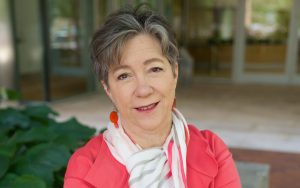Pioneering Biological Innovation and Gender Equality
In honor of Women’s History Month, we are highlighting three prominent female faculty members who have made department history.

Lisa Steiner
Professor of Immunology
Lisa Steiner was MIT Biology’s first female faculty member, and continues to teach undergraduates to this day. She grew up in Vienna during World War II, but fled as a young child with her mother just days before Hitler annexed Austria into Nazi Germany in 1938. At their new home in New York, Steiner became enthralled by numbers, and ultimately majored in math at Swarthmore College. Although she considered pursuing medicine, her senior year she opted to continue studying math in graduate school at Harvard University.
“The best math department in the country at that time was at Princeton, but Princeton did not accept women,” she told MIT News. “It bothered me a very small amount. I shrugged my shoulders and said, well, I’ll go to Harvard.”
After just one year, Steiner had exhausted the university’s math classes, and began cycling to MIT to supplement her course load with topology. Still, her mathematics program was not what she had envisioned, and she applied to Yale School of Medicine, where she received her MD in 1959. Over the course of her time at medical school, Steiner developed a passion for immunology.
One of her experiments involved using reagents to unfold an enzyme called ribonuclease A. Removing these reagents not only prompted the enzyme to spontaneously refold, but also allowed it to recover its original structure and function. This same experiment later laid the foundation for Christian Anfinsen’s 1972 Nobel Prize, but because Steiner’s superiors did not deem her findings significant, they were never published and her initial results garnered no attention.
When she first arrived at MIT Biology in 1967, Steiner was the department’s only female professor, and there were very few women undergraduates or graduate students. As a professor of immunology, she explored the range of structural variation among antibodies in vertebrate species, including frogs. She found that these antibodies — while sharing certain basic features such as variable and constant regions — can be unexpectedly diverse in structure, varying in number of polypeptide chains or in pattern of disulfide bridging. Moreover, the polypeptide chains in non-mammalian vertebrates do not generally fall into classifications developed for mammalian antibodies, such as kappa, lambda, gamma, and so on. Later, she turned to the zebrafish to probe white blood cells and their role in the immune system.
Today, women represent 24% of Biology faculty, 85% of Course 7 and 7A majors, and more than half the graduate student body. Although she has closed her lab, Steiner continues to serve as an inspiration to trainees in the biology community and beyond.

Nancy Hopkins
Amgen Inc. Professor of Biology Emerita
Nancy Hopkins is known for many things, including pioneering zebrafish as a model organism and sparking an investigation that resulted in a landmark report on the status of women at MIT in 1999. Now, as the Amgen professor of biology emerita at MIT, she is winding down an extraordinary career.
Although she was born into a family of scientists and engineers, Hopkins didn’t seriously consider pursuing biology until her junior year at Radcliffe College, when she attended a lecture by geneticist James Watson (who, along with Francis Crick, first proposed the double helix structure of DNA). Hopkins worked in Watson’s laboratory for the next year and a half, studying the Lambda repressor, a protein that maintains the lysogenic life cycle of the Lambda bacteriophage by controlling the expression of specific genes. She briefly attended graduate school at Yale University, but returned to Harvard shortly thereafter to continue her Lambda repressor project. By the time she finished her PhD, Watson had established the Cold Spring Harbor Laboratory in New York, and Hopkins joined him there to investigate tumor viruses. She commuted from Boston to New York for two years, which required a 10-hour train ride.
In 1973, Hopkins was recruited to MIT by Salvador Luria and David Baltimore as an assistant professor at the new Center for Cancer Research. “The timing was just perfect to provide the right facility in which to work on cancer, the thing that I had wanted to work on all my scientific life,” she told PNAS. She even shared an office with professor Phil Sharp, who went on to receive the 1993 Nobel Prize in Physiology or Medicine for his co-discovery of RNA splicing.
Hopkins began by investigating RNA tumor viruses, identifying genes that determine host range and the type and severity of cancers mouse retroviruses cause. These genes included capsid protein p30 and transcriptional elements now known as enhancers. However, she switched research areas more than a decade later, developing tools for zebrafish research and devising an efficient method for large-scale insertional mutagenesis. Using this technique, her lab identified and cloned 25% of the genes essential for a fertilized zebrafish egg to develop into a swimming larva. These genes included known and novel genes that predispose fish to cancer.
Since her retirement in 2014, Hopkins has primarily focused on cancer prevention advocacy and early detection research. She also continues to work to achieve gender equity and greater faculty diversity within MIT.

Susan Lindquist
Former Director of the Whitehead Institute and Professor of Biology
Before she passed away from cancer in 2016, Susan Lindquist led a 40-year career as a well-respected researcher with a global reputation for biomedical innovation. She was the director of the Whitehead Institute from 2001 to 2004, becoming one of the first women in the country to lead a major independent research organization.
Born on June 5, 1949, Lindquist earned her undergraduate degree in microbiology from University of Illinois at Urbana-Champaign and her PhD in biology from Harvard University. She was a professor at the University of Chicago for 23 years before arriving at MIT in 2001, serving as the director of the Whitehead Institute for three years. Afterwards, she remained at MIT but resumed her research focus, supervising 115 fellows, graduate students, and undergraduates at the Whitehead alone.
Lindquist used budding yeast to study protein folding, and in doing so transformed yeast into a widely-used system for studying human disease, evolution, and biomaterials. She mainly investigated prions, misfolded proteins or “proteinaceous infectious particles” that are responsible for neurodegenerative disorders like Creutzfeldt-Jakob disease. She showed that prions can produce new traits that get passed down from one generation to the next without altering the genetic code. This variation helps cells survive despite changes to their environment, as well as develop advantageous new traits. Lindquist also devised a new method in yeast to study disease-causing changes that affect protein folding, in order to test potential therapies to prevent protein toxicity in humans. In 2010, she was awarded the National Medal of Science.
A pioneer and leader, Lindquist was loved and respected by the community. “Sue has meant so much to Whitehead as an institution of science, and as a community of scientists, and her passing leaves us diminished in so many ways,” David Page, current director of Whitehead Institute, told MIT News. “She was a risk-taker and an innovator. She believed that if we were not reaching for things beyond our grasp, we were not doing our job as researchers; if we were not constantly striving for that which we could only imagine, we were not fulfilling our obligations to society as scientists.”
